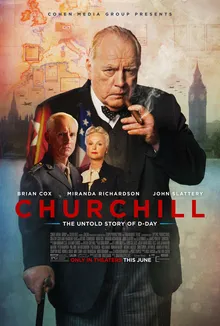Historical accuracy of Churchill

Historical accuracy of Churchill

Characters
Winston Churchill (Brian Cox)
While Cox captures some mannerisms, the film's core depiction of Churchill as vehemently opposing D-Day in June 1944 due to depression and fear is considered historically inaccurate by numerous historians. By 1944, he was committed to the operation.
Clementine Churchill (Miranda Richardson)
Clementine was indeed a crucial support for Winston. However, specific scenes depicting extreme marital strife (like slapping him or packing bags to leave) immediately before D-Day are considered dramatic inventions and unlikely.
Gen. Dwight D. Eisenhower (John Slattery)
Eisenhower was the Supreme Commander. The film depicts intense clashes with Churchill over D-Day; while disagreements occurred earlier, this level of conflict days before the invasion is disputed. Slattery's physical resemblance was also questioned.
Field Marshal Bernard Montgomery (J. Wadham)
Montgomery was a key British commander for D-Day. The film shows him firmly supporting the plan against Churchill's alleged opposition; depictions of extreme disrespect towards Churchill (calling him a "bastard") are highly improbable.
King George VI (James Purefoy)
Portrayed accurately in his supportive relationship with Churchill and, crucially, in his historically documented role of persuading Churchill not to personally sail with the D-Day invasion fleet.
Gen. Alan Brooke (Danny Webb)
Brooke often mediated Churchill's strategic ideas. His presence is accurate, but his interactions are framed within the film's disputed premise of Churchill's last-minute opposition.
More characters
Helen Garrett (Ella Purnell)
A fictional character created to serve as an audience viewpoint, witness Churchill's turmoil, and provide an emotional subplot involving a fiancé participating in D-Day.
Jan Smuts (Richard Durden)
Accurately depicted as the respected South African leader and member of the British War Cabinet, offering counsel to Churchill.
Story
Film's timeframe: 96 hours before D-Day (June 1944)
The movie accurately sets its focus on the specific, tense days immediately preceding the Normandy landings.
Churchill's vehement opposition to Operation Overlord
This is the film's central, widely disputed claim. Historical evidence shows Churchill, despite earlier reservations (in 1942-43) and anxieties, was fully supportive and committed to the D-Day plan by June 1944.
Churchill haunted by Gallipoli fears
Churchill was indeed deeply affected by the disastrous Gallipoli campaign of WWI, and this historical trauma informed his caution regarding large-scale amphibious assaults throughout WWII.
Intense clashes between Churchill and Allied Commanders
The film exaggerates the conflict between Churchill and figures like Eisenhower and Montgomery in the days immediately before D-Day. Major strategic debates had occurred much earlier.
Churchill suffering severe depression ("black dog")
While Churchill experienced lifelong depression, depicting him as nearly incapacitated and actively undermining the Allied high command due to it in June 1944 is considered a gross misrepresentation by historians.
Churchill attempting to postpone/cancel D-Day
There is no historical evidence that Churchill attempted to stop or significantly delay Operation Overlord just days before its launch.
Churchill wanting to join the D-Day invasion fleet
This incident is historically accurate; Churchill did express a strong desire to witness the landings from a warship and was famously talked out of it by King George VI for safety and constitutional reasons.
Clementine's efforts to manage/support Winston
Clementine played a vital role in supporting her husband throughout the war, often managing his moods and health, a dynamic the film reflects accurately in principle.
King George VI providing counsel and support
The supportive working relationship between the King and the Prime Minister during the war is accurately portrayed.
Setting
Britain, June 1944 (Pre D-Day)
Effectively captures the tense atmosphere of Britain as it prepared for the massive Allied invasion of Europe.
War Rooms / Government Offices
Settings like the underground War Rooms, Downing Street, and Chequers convincingly represent the centers of British political and military decision-making during the war.
Coastal areas (Southern England)
Scenes showing Churchill near the coast accurately reflect the staging areas for the D-Day invasion force.
Period Dress (Military Uniforms, Civilian)
Costumes accurately reflect British military uniforms and civilian attire appropriate for 1944.
Props and Technology (Vehicles, phones etc.)
Technology and vehicles shown are consistent with the mid-1940s wartime setting.
Atmosphere of Secrecy and Anticipation
Successfully conveys the immense pressure, secrecy, and anxiety surrounding the planning and launch of Operation Overlord.
Weather's Importance for D-Day
The film accurately highlights the critical role weather forecasting played in the final decision regarding the timing of the D-Day landings.
